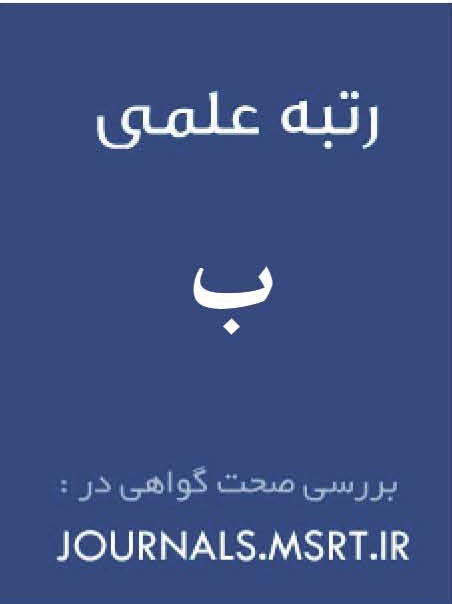عوامل مؤثر بر اثربخشی مدیریت ریسک نقدینگی در بانکهای عراقی
کلمات کلیدی:
مدیریت ریسک, نقدینگی, سیاست پولیچکیده
بانکها نقش حیاتی در ایجاد نقدینگی و تبدیل ریسک در عملیات اقتصادی هر کشوری در سطح خرد یا کلان ایفا میکنند. بانکهای تجاری از بدهیهای نسبتاً با نقدینگی بالا در راستای تأمین مالی داراییهای نسبتاً غیرنقد استفاده میکنند، بنابراین نقدینگی فردی خود را برای حفظ عملکرد عادی سیستم مالی و ارتقای توسعه اقتصادی آزاد میکنند. بر این اساس پژوهش حاضر با هدف شناسایی عوامل مؤثر بر اثربخشی مدیریت ریسک نقدینگی در بانکهای عراقی به انجام رسیده است. با تكیه بر تحلیل حوزه دانش و الگوی كیفی تحلیل محتوی عوامل مؤثر بر اثربخشی مدیریت ریسک نقدینگی در بانکهای عراقی شناسایی گردید. سپس با نظر سنجی اقناعی دلفی، ۱۷ نفر از صاحب نظران در حوزه مدیریت ریسک، به روش غیر تصادفی انتخاب و با الگوی تحلیل شبكه فازی اقدام به ارزیابی و پالایش مؤثرترین سنجههای اندازهگیری متغیرها و تبیین مدل نهایی پیشنهادی گردید. بر مبنای تحلیلهای نهایی، اثربخشی مدیریت ریسک مشتمل بر 10 خوانش سازمانی، سازگاری و انطباق، فشار رقابتی، پیچیدگی، حمایت دولت، توانمندیهای مدیریتی، عدم اطمینان در بازار، مزیت نسبی، توانمندیهای فنی و همراهی ذی نفعان به عنوان عوامل مؤثر تلقی و مؤلفههای اندازهگیری آنها شناسایی و پالایش گردید. در این پژوهش عوامل مؤثر بر اثربخشی مدیریت ریسک نقدینگی در بانکهای عراقی شناسایی گردید و سپس به ارایه یک مدل مؤثر جهت اندازهگیری مؤلفههای فنی پرداخته شد.
دانلودها
مراجع
Abdul-Rahman, A., Sulaiman, A. A., & Said, N. L. H. M. (2018). Does financing structure affects bank liquidity risk? Pacific-Basin Finance Journal, 52, 26-39. https://doi.org/10.1016/j.pacfin.2017.04.004ER -
Anginer, D., Bertay, A. C., Cull, R., Demirgüç-Kunt, A., & Mare, D. S. (2019). Bank regulation and supervision ten years after the global financial crisis (Vol. 9044). World Bank Policy Research Working Paper. https://doi.org/10.1596/1813-9450-9044
Ashraf, B. N., Zheng, C., Jiang, C., & Qian, N. (2020). Capital regulation, deposit insurance and bank risk: International evidence from normal and crisis periods. Research in International Business and Finance, 52, 101188. https://doi.org/10.1016/j.ribaf.2020.101188
Basiruddin, R., & Ahmed, H. (2020). Corporate governance and Shariah non-compliant risk in Islamic banks: evidence from Southeast Asia. Corporate Governance: The International Journal of Business in Society, 20(2), 240-262. https://doi.org/10.1108/CG-05-2019-0138
Budhathoki, P. B. (2024). The Impact of Liquidity on Common Stocks Returns: Empirical Insights From Commercial Banks in Nepal. Banks and Bank Systems, 19(1), 148-156. https://doi.org/10.21511/bbs.19(1).2024.13
Chiang, S. L., & Tsai, M. S. (2020). The valuation of deposit insurance allowing for the interest rate spread and early-bankruptcy risk. The Quarterly Review of Economics and Finance, 76, 345-356. https://doi.org/10.1016/j.qref.2019.09.008
Habib, S. F. (2018). Fundamentals of Islamic finance and banking. John Wiley & Sons. https://doi.org/10.1002/9781119371076
Hassan, M. K., Sohel, M. N. I., Choudhury, T., & Rashid, M. (2024). A systematic literature review of risks in Islamic banking system: research agenda and future research directions. Risk management, 26(1). https://doi.org/10.1057/s41283-023-00135-zER -
Heliani, H. (2023). Relationship Between Working Capital Management, Corporate Social Responsibility, Liquidity Risk, and Profitability on the Performance and Sustainability. International Journal of Business Law and Education, 4(2), 1257-1269. https://doi.org/10.56442/ijble.v4i2.315
Imam, P., & Kpodar, K. (2016). Islamic banking: good for growth? Economic Modelling, 59, 387-401DO - 310.1016/j.econmod.2016.1008.1004.
Ji, Y., Bian, W., & Huang, Y. (2018). Deposit insurance, bank exit, and spillover effects. Journal of Banking & Finance, 96, 268-276. https://doi.org/10.1016/j.jbankfin.2018.09.013
Johari, E. E. C., Chronopoulos, D. K., Scholtens, B., Sobiech, A. L., & Wilson, J. O. (2020). Deposit insurance and bank dividend policy. Journal of Financial Stability, 48, 100745. https://doi.org/10.1016/j.jfs.2020.100745
Jordà, Ò., Richter, B., Schularick, M., & Taylor, A. M. (2021). Bank capital redux: solvency, liquidity, and crisis. The Review of Economic Studies, 88(1), 260-286. https://doi.org/10.1093/restud/rdaa040
Liu, S., Wang, B., & Zhang, Q. (2024). Fintech regulation and bank liquidity creation: Evidence from China. Pacific-Basin Finance Journal, 84, 102276. https://doi.org/10.1016/j.pacfin.2024.102276
Lu, H. (2023). Ripple Through the Silk Road: Analysis of Liquidity Risk Spillover Effects in Stock Markets of Belt and Road Initiative Countries. Advances in Economics and Management Research, 8(1), 318. https://doi.org/10.56028/aemr.8.1.318.2023
Moenninghoff, S. C. (2018). The Regulation of Systemically Relevant Banks. https://doi.org/10.1007/978-3-658-23811-7
Nguyen, Q. K. (2021). Oversight of bank risk-taking by audit committees and Sharia committees: conventional vs Islamic banks. Heliyon, 7(8). https://doi.org/10.1016/j.heliyon.2021.e07798
Quansah, M. K. (2023). Liquidity and Performance of Banks Listed on the Ghana Stock Exchange. Interdiciplinary Journal and Hummanity (Injurity), 2(5), 456-465. https://doi.org/10.58631/injurity.v2i5.77
Safiullah, M., & Shamsuddin, A. (2018). Risk in Islamic banking and corporate governance. Pacific-Basin Finance Journal, 47, 129-149. https://doi.org/10.1016/j.pacfin.2017.12.008
Sajiwo, B., & Arifin, Z. (2023). The Effect of Liquidity, Investment Opportunity Set, Free Cash Flow, and State-Owned Enterprise on the Dividend Policy of Bank Listed in the Indonesia Stock Exchange. International Journal of Multidisciplinary Research and Analysis, 06(04). https://doi.org/10.47191/ijmra/v6-i4-09
دانلود
چاپ شده
ارسال
بازنگری
پذیرش
شماره
نوع مقاله
مجوز
حق نشر 2025 Ahamad Jabbar Mahammad (Author); Mahdi Madanchi Zaj (Corresponding author); Gholamreza Zomorodian, Hamidreza Kordlouie (Author)

این پروژه تحت مجوز بین المللی Creative Commons Attribution-NonCommercial 4.0 می باشد.









